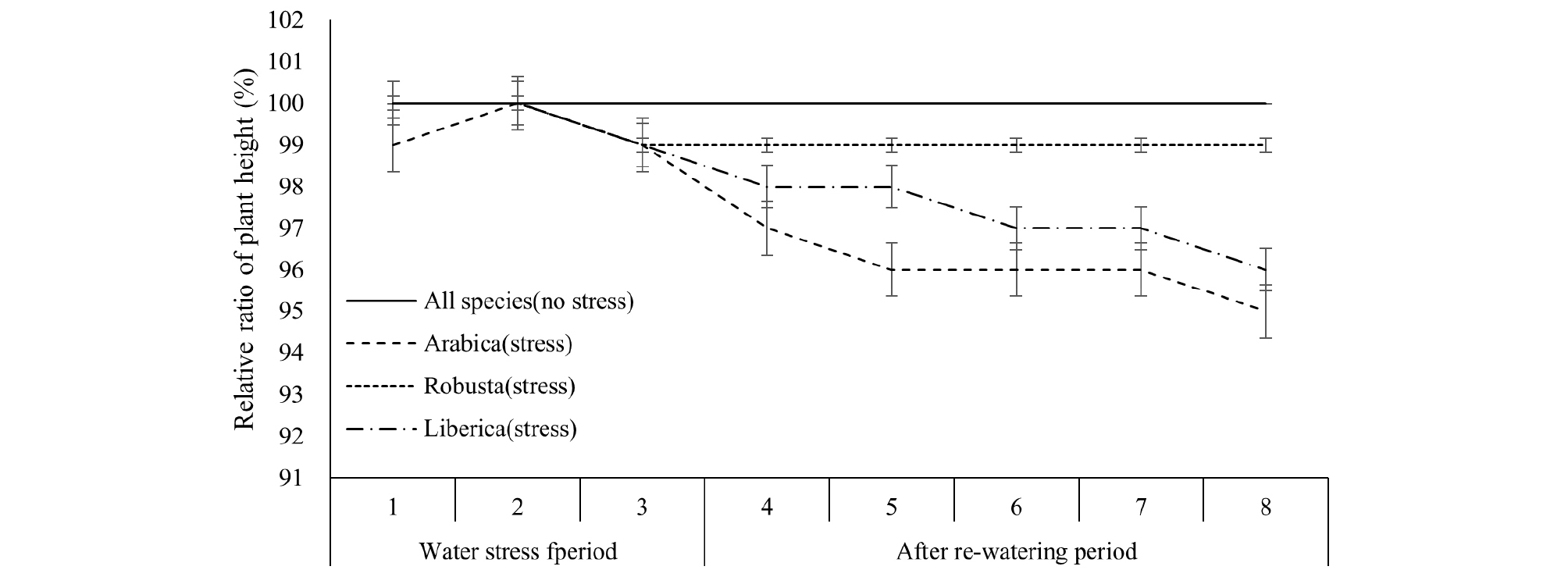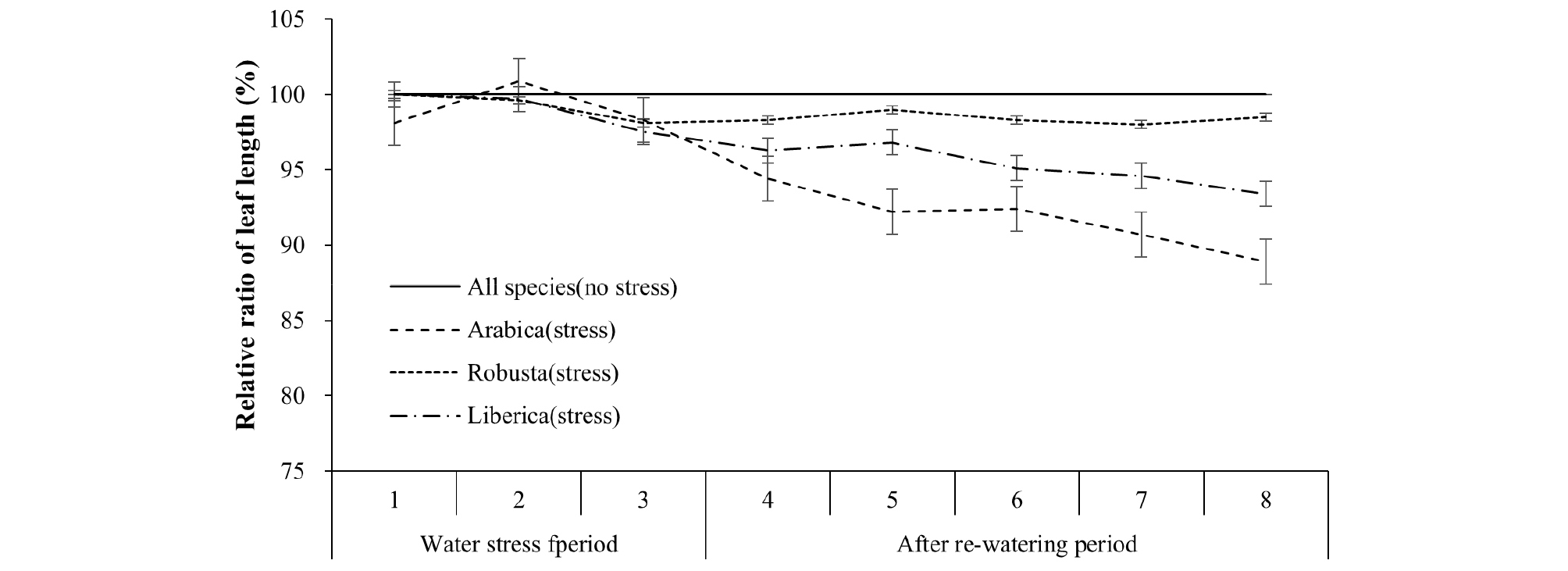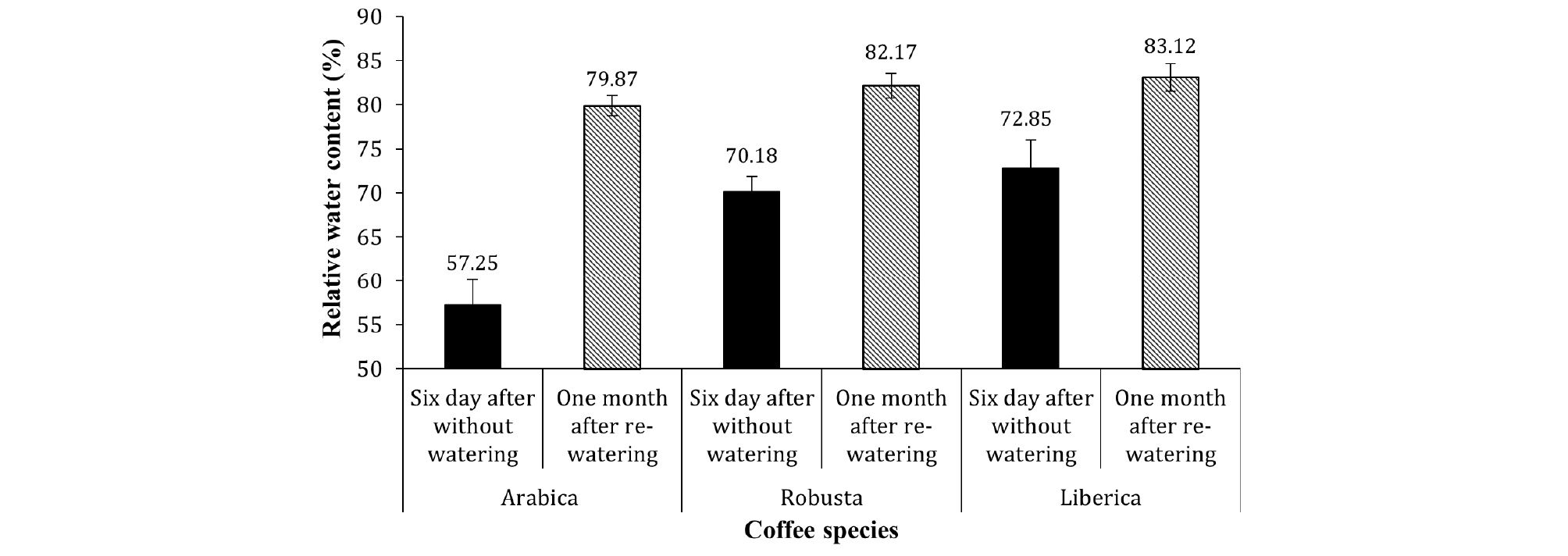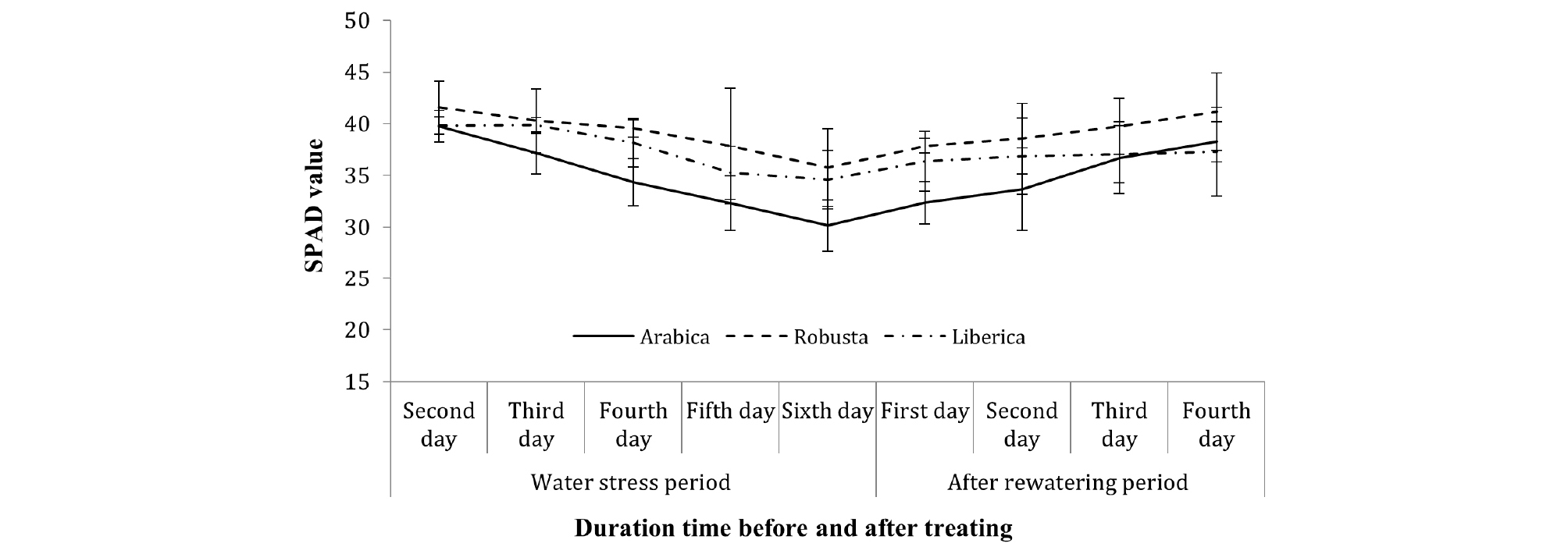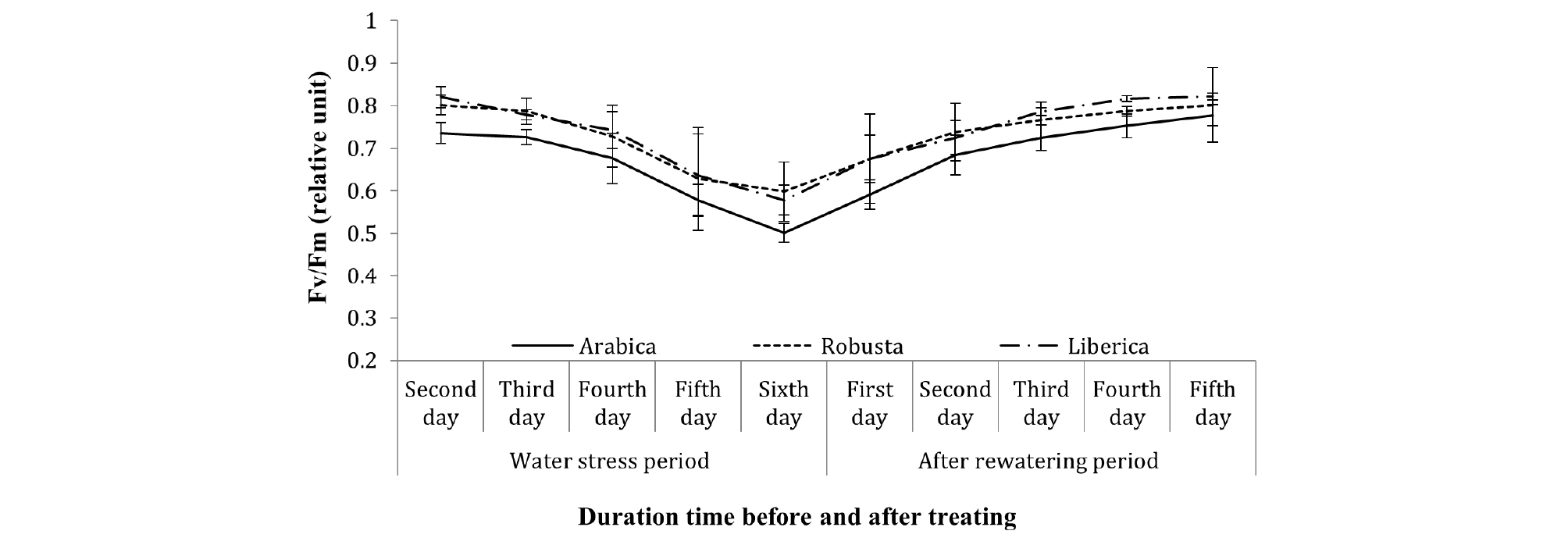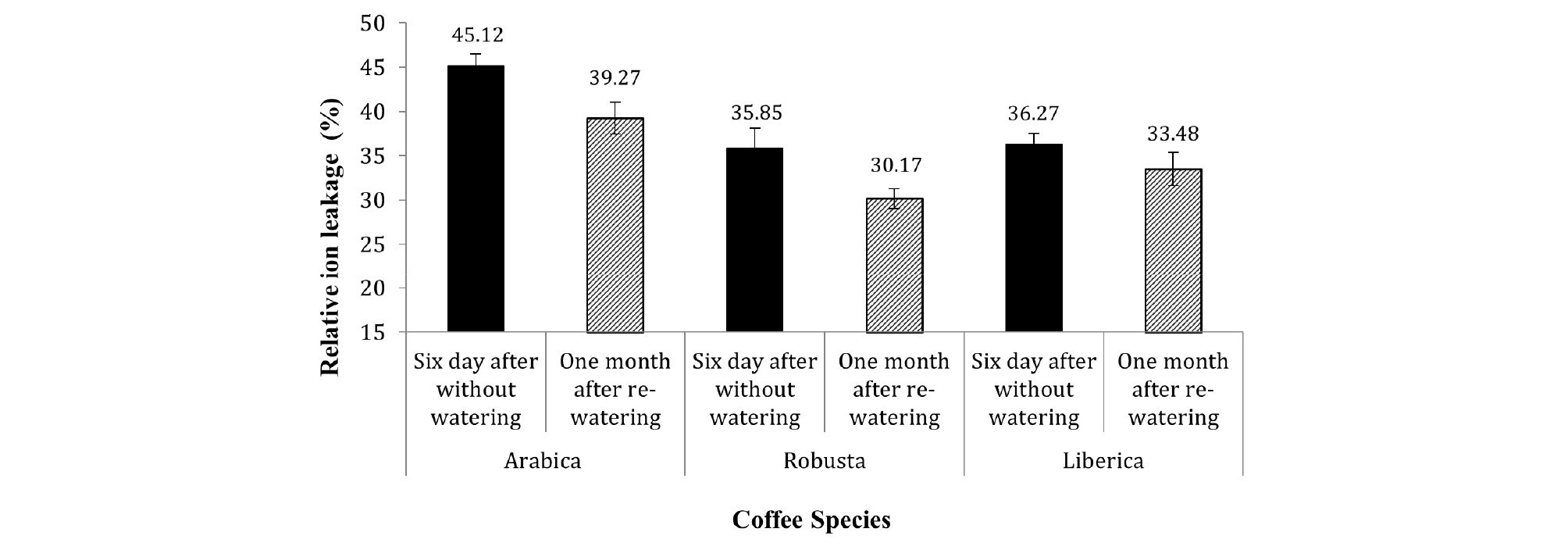Introduction
Materials and Methods
Plant material and soil condition
Water stress treatment
Data collection and analysis
Results
Discussion
Introduction
Coffee is one of the most important agricultural products in the international market. It is cultivated in different latitudes around the world, but its distribution depends on many climate factors such as location, soil types, shading and management practices (Wintgens, 2015).
Drought is considered one of the major environmental factors limiting coffee plant growth and yield in most coffee growing areas (DaMatta and Ramalho, 2006). However, only little progress has been achieved in breeding for drought resistance of coffee worldwide. Some drought tolerance traits have been identified in coffee genotypes such as deeper root system in (Pinheiro et al., 2005) and larger root dry mass in drought tolerant clones than in drought sensitive ones (DaMatta and Ramalho, 2006). On the other hand, compared with C. arabica, C. robusta species generally appears to be more vigorous, productive and robust. However, the quality of the beverage derived from its beans is considerably inferior to that from C. arabica (Coste, 1992).
Although some morphological and physiological traits important for selecting drought and heat tolerant coffee genotypes have been reviewed by Cheserek and Gichimu (2012), little information is available on comparison of the agronomical traits associated with physiological characteristics in three coffee species (C. arabica, C. robusta and C. liberica) under water deficit condition. Therefore, the objective of this study was to determine the growth and physiological responses of 3 species of coffee (C. arabica, C. robusta and C. liberica) as affected by water deficit condition.
Materials and Methods
Plant material and soil condition
Each of 120 plastic pots (19 cm diameter × 18 cm tall) was filled with a mountain soil obtained from at Son La province of Vietnam. Each pot contained 4 kg of dry soil (the chemical properties of soil were present in Table 1). Three coffee species with one year old (C. arabica, C. robusta and C. liberica) were used for the cultivation experiment. The plants were individually transplanted as one plant in each pot and then plants were fertilized using overhead irrigation once a week with modified Hoagland solution (Hoagland and Arnon, 1950). The experiment was carried out in a plastic house at Vietnam National University of Agriculture.
Table 1. Physicochemical properties of the soil in this study
Water stress treatment
Irrigation was supplied to all treatments at field capacity level from the time of transplanting until the plants reached 1 year-old. For water stress treatment, without irrigation was treated until wilted plants. One week after without irrigation, plants were re-watered.
Data collection and analysis
Ten coffee plants per treatment at the 6 days after without irrigation and 30 days after re-watering were collected for analysis of growth and physiology characteristics. Plant height (cm) and leaf length (cm) and leaf width (cm) were measured. Leaf area (cm2) was measured with a leaf area meter (Delta-T Device Ltd., Burwell, Cambridge, UK), leaf chlorophyll value was measured using a chlorophyll meter (SPAD-502 Plus, Konica Minolta Sensing Inc., Osaka, Japan). The fresh shoot and root were dried in an oven (MOV-212F, Sanyo Electric Co., Ltd., Osaka, Japan) at 80°C for 72 h before measuring the dry mater.
Chlorophyll a fluorescence: A portable fluorometer (Opti-Sciences Chlorophyll Fluorometer, Hudson, USA. Model OS- 30p), was used to measure the potential quantum efficiency of photosystem II (Fv/Fm). Fluorescence determinations were performed between 08:00 h and 11:00 h.
Relative water content in the leaf (RWC): Ten leaf discs per treatment were made up. Leaves were taken from the youngest fully expanded leaves. Leaf discs were immediately weighed (fresh weight, FW). The leaf discs were floated in distilled water inside the porous platform at a temperature range between 25-30°C in order to obtain turgid weight (TW). At the end of imbibition period, leaf discs were placed in a oven at 80°C for 48 hours, in order to obtain dry weight (DW). Values of FW, TW and DW were used to calculate RWC, using the Equation (1):
| $$\begin{array}{l}RWC\;(\%)\;=\frac{FW-DW}{TW-DW}\times100\\\end{array}$$ | (1) |
Relative ion leakage was also assessed by the leakage of electrolytes from the leaves of ten plants of similar size. Leakage of electrolytes was determined using a conductivity meter (AG 8603, SevenEasy, Mettler Toledo, Switzerland). The leaf segments (disks of leaves with d = 1 cm2) were washed, blotted dry, weighted and put in stopped vials filled with the exact volume of deionized water. The vials were then incubated for 2 hours in darkness with continuous shaking and then conduction (C1) was measured. The vials were heated at 80°C for 2 hours and the conduction (C2) was measured again. The electrolyte leakage was expressed as percentage of relative ion leakage, which was calculated according to this equation (Zhao et al., 2007): Relative electrolyte leakage (%) = C1/C2 × 100
Percentage of wilted plant in drought stress were calculated when 75% of leaves per plant withered.
The experiment was design a split-plot. Water stress is the main plot and coffee species were the sub plot in this experiment. For the statistical analysis of growth and physiology parameters, ten plants per treatment were randomly selected. Data were analyzed using IRISTAT 5.0 and Microsoft Excel software.
Results
Variations in plant height of 3 coffee species (C. arabica, C. robusta and C. liberica) in response to water deficit condition compared to control are given in Fig. 1. No significant difference in plant height was observed between plants grown under water stress and control during the first 2 weeks of water stress treatment. Significant difference in plant height between water stress and control was observed after re-watering in C. arabica and C. liberica species. Water stress led to significant decrease in plant height compared to control. However, no significant difference in plant height between plants under water stress and control was recorded in C. robusta species after re-watering period.
There was no sdifferenceignificant difference in leaf length of coffee plants grown in control and water deficit conditions in the first 2 weeks. However, significant difference in leaf length was observed in plants between control and water tress treatments after re-watering. Water deficit significantly reduced leaf length of C. arabica and C. liberica species after re-watering period. Under control treatment, highest leaf length was observed in C. liberica and the lowest was recorded in C. Arabica species. No significant difference in leaf length was found in C. robusta species grown in control and water deficit treatments (Fig. 2).
No significant difference in leaf width was found between plants grown under control and water stress conditions during the first 2 weeks of the study. But leaf width statistically differed among coffee species. Significant difference in leaf width was recorded between control and water stress treatments after re-watering period. Compared to the control treatments, leaf width of all coffee species decreased significantly in water stress after re-watering period.
Data regarding leaf area in Table 2 indicated a decreasing trend in leaf area both during water stress period and after re-watering period in water stress treatments compared to control treatments. Significant differences in leaf area between control and water tress treatments were recorded in 3 coffee species in both checking times (6th day of water stress treatment and one month after re-watering). At 6th day of water stress, the highest reduction in leaf area (5.07%) compared to control was observed in C. arabica species, but this reduction was not statistically different with that in C. robusta species (2.92%) and C. liberica species (2.37%). One month after re-watering, significant reductions (compared to control) in leaf area were still observed in water stress treatment. Highest reduction in leaf area was recorded in C. arabica species (11.22%) and the lowest was seen in C. robusta species (5.11%).
Table 2. Effect of water stress on leaf area of C. arabica, C.robusta and C. liberica species
Variations of fresh and dry shoot weight of 3 coffee species (C. arabica, C.robusta and C. liberica) in response to water stress at one month after re-watering were shown in Table 3. The results revealed a decrease in fresh and dry shoot weight in C. arabica species in water stress compared to control treatments. One month after re-watering, plants grown under water stressed condition obtained significant reductions in fresh and dry weight compared to control treatments. The highest reduction in shoot fresh weight (compared to control) was observed in C. arabica species, followed by C. liberica species and was lowest at C. robusta species. The highest reduction in shoot dry weight was recorded in C. arabica species and was lowest in C. robusta species.
Table 3. Effect of water stress on fresh and dry weights of the shoot of C. arabica, C. robusta and C. liberica species after one month of re-watering
Data regarding root fresh and dry weight of 3 coffee species (C. arabica, C. robusta and C. liberica) at one month after re-watering were presented in Table 4. Fresh and dry root weight showed a decrease in water stress treatments compared to control in all coffee species. One month after re-watering, the highest decrease of root fresh weight compared to control was recorded in C. arabica species with 14.95% and the lowest was observed in C. robusta species with 2.99%.
Table 4. Effect of water stress on fresh and dry weights of the root of C. arabica, C. robusta and C. liberica species after one month of re-watering
Relative water content (RWC) is considered one of fastest agricultural parameters used for screening of drought tolerance in plants. Data regarding effect of water stress on RWC in coffee leaf were presented in Fig. 3. Under water deficit condition, highest value of leaf RWC was observed in the C. liberica species and the lowest value was recorded in C. arabica species.
Chlorophyll content (SPAD value) of all coffee species decreased significantly with increasing duration of treating water stress (Fig. 4). However, chlorophyll content of all coffee species increased significantly with increasing duration of re-watering. The lowest value of SPAD was observed in C. arabica species.
Measurements of maximum quantum efficiency of photosystem II (Fv/Fm) in leaf of C. arabica, C. robusta and C. liberica species were presented in Fig. 5. Maximum quantum efficiency of photosystem II (Fv/Fm) of all coffee species decreased significantly with increased water deficit duration. Under water stress, no significant difference was found among plants of C. robusta and C. liberica species. However, lowest Fv/Fm value under water stress period was recorded in C. arabica species. After re-watering period, Fv/Fm of all coffee species were recovered (Fig. 5).
Electrolyte leakage is another parameter associated with drought stress in plant. In this study, the result shown that, water stress led to significant decrease in leaf electrical conductivity of all three coffee species (Fig. 6). After six day of water withholding, highest value of ion leakage (45.12%) was observed in C. arabica species while the lowest (35.58%) was seen in C. robusta species. However no significant difference in ion leakage was found among plants of C. robusta and C. liberica species.
Plant wilting and recovering are two important parameters in studying of drought tolerance in plants. The starting time of wilting was first observed after 4 days of water withholding in C. arabica species. The highest value of plant wilting (65.17%) was also observed in C. arabica species at 5 days of water withholding. The lowest wilting percentage was recorded in C. robusta species (42.10%). Six days of water withholding led to 100% wilted plants observed in C. arabica species while this was 72.33% in C. liberica and 65.53% in C. robusta species. After 2 days of re-watering 100% of C. robusta and C. liberica species were recovered (Table 5).
Table 5. Effect of water stress on plant wilting and recovery after re-watering of C. arabica, C. robusta and C. liberica species
Discussion
Drought stress has been widely reported to cause perturbance in water homeostasis (Ashraf, 2010). The decline in the availability of water in plant body leads to molecular damage, growth inhibition and even death (Ashraf, 2010; Mittler, 2002). In addition, it has been reported that decrease in shoot growth and leaf area and increases in leaf thickness and root: shoot ratio with soil moisture depletion are believed to be among the important stress avoidance or tolerance mechanisms in plants (Tesfaye et al., 2014). Therefore, in this study, water stress significantly reduced plant height, leaf length, leaf width of C. arabica and C. liberica species. However water deficit did not lead to significant reduction in these parameters in C. robusta species.
Important morphological and physiological traits in selecting drought and heat tolerant coffee genotypes have been reviewed by Cheserek and Gichimu (2012). In this line, studies on C. robusta coffee has shown a deeper root system (Pinheiro et al., 2005) and larger root dry mass in drought tolerant clones than in drought sensitive ones (DaMatta and Ramalho, 2006). In our study, the highest reduction in leaf area, shoot and root fresh weight were observed in C. arabica species under water stress. However, these reductions were not statistically significant compared to that in C. robusta and C. liberica species. This result agreed with many studies on C. robusta species has shown a deeper root system (Pinheiro et al., 2005) and larger root dry mass in drought tolerant clones than in drought sensitive ones (DaMatta and Ramalho, 2006). Anim-Kwapong et al. (2011) also reported existence of a large diversity among C. robusta coffee genotypes around the world for drought tolerance, although these variabilities have not been well-studied and documented in relation to morphological traits. On the other hand, compared with C. arabica, C. robusta species generally appears to be more vigorous, productive and robust (Coste, 1992).
Relative water content (RWC) is considered one common parameters used for screening of plants with drought tolerance. RWC was maintained at higher amount in drought tolerant plants compared to that in drought sensitive species. Coffee retains high leaf relative water content (RWC) under dehydrating conditions, being considered water saving rather than a dehydrating tolerant species (Nunes, 1976; DaMatta et al., 1993). In this study, under water stress, the highest value of relative water content in the leaf was observed in C. liberica species, followed by C. robusta species and was lowest in C. arabica species.
In addition, chlorophyll value and Fv/Fm of all coffee species decreased significantly with increasing water deficit duration. However, chlorophyll value and Fv/Fm of all coffee species were recovered after re-watering. The highest value of SPAD was observed in C. robusta species, followed by C. liberica species.
In conclusion, the growth parameters of C. arabica and C. liberica species decreased significantly in water deficit condition but they did not statistically differ in C. robusta species. On the other hand, C. robusta species generally appear to be more vigorous in physiology characteristics compared with C. arabica and C. liberica species.



